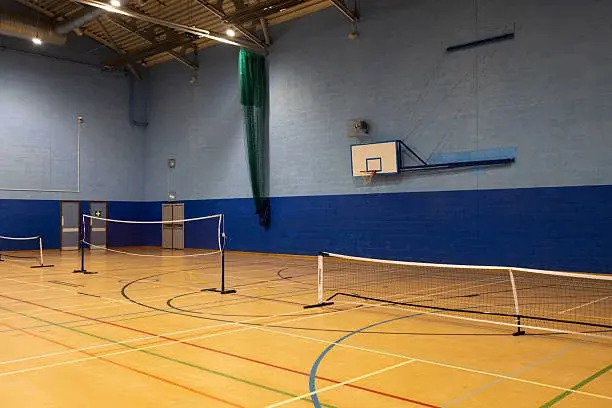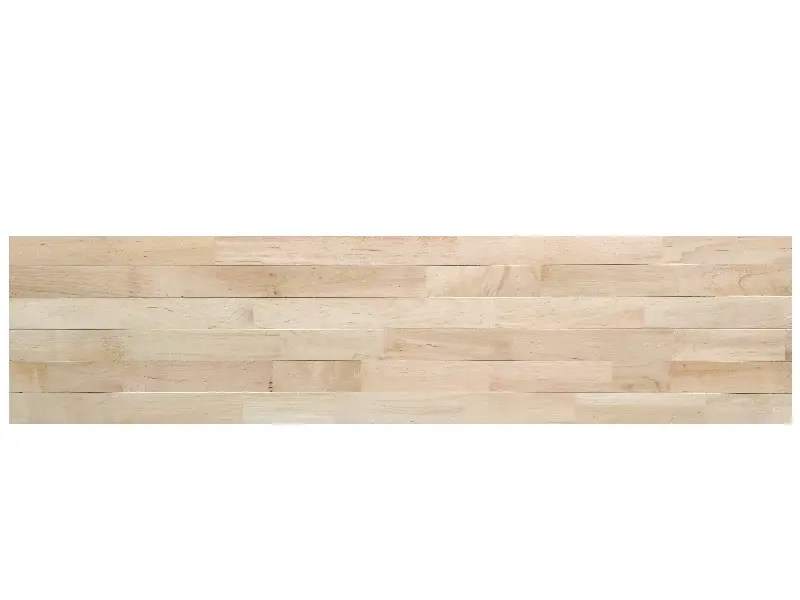What are the best wood species for a badminton court’s wooden flooring?
When it comes to creating the perfect badminton court, choosing the right wooden flooring is crucial. Badminton court wooden flooring can significantly impact player performance, safety, and the overall longevity of the court. The wood species you select plays a vital role in determining the floor's durability, shock absorption, and surface consistency, all of which contribute to the quality of the game. In this comprehensive guide, we'll explore the best wood species for badminton court flooring, comparing their characteristics and helping you make an informed decision for your facility.

Comparing Maple, Oak, and Beech for Durability and Playability
Three wood species stand out as top contenders for badminton court flooring: maple, oak, and beech. Each of these hardwoods offers unique properties that can enhance the playing experience and withstand the rigors of competitive play.
Maple: The Gold Standard
Maple, particularly Northern Maple, is widely regarded as the premier choice for badminton court flooring. Its dense grain structure and uniform texture provide excellent stability and consistency across the court surface. Maple's natural resilience allows it to absorb shock effectively, reducing strain on players' joints during intense matches.
Oak: Strength and Character
Oak is known for its exceptional strength and distinctive grain patterns. While not as commonly used as maple for badminton courts, oak offers excellent durability and can withstand heavy foot traffic. Its slightly more textured surface may provide additional grip for players, but it can also affect ball bounce consistency.
Beech: A Balanced Option
Beech wood strikes a balance between maple and oak in terms of hardness and grain structure. It offers good durability and a relatively smooth playing surface. Beech is often more affordable than maple, making it an attractive option for facilities working within budget constraints.
How Does Wood Hardness (Janka Scale) Impact Athlete Performance?
The Janka hardness scale is a crucial factor in determining a wood species' suitability for sports flooring. This scale measures the force required to embed a steel ball halfway into a wood sample, providing insights into the wood's resistance to denting and wear.
Janka Hardness Ratings for Common Badminton Court Woods
- Hard Maple: 1,450 lbf (pounds-force)
- Red Oak: 1,290 lbf
- Beech: 1,300 lbf
A higher Janka rating typically indicates better durability and resistance to impact. However, extremely hard woods can lead to increased fatigue and potential injury for athletes due to reduced shock absorption.
Finding the Sweet Spot
The ideal badminton court wooden flooring strikes a balance between hardness for durability and sufficient give for player comfort. Maple's Janka rating of 1,450 lbf provides this optimal balance, offering excellent resilience while still allowing for some flex to absorb impacts.
The Role of Shock Absorption and Surface Consistency
Shock absorption and surface consistency are critical factors in badminton court flooring performance. These properties directly impact player safety, comfort, and the overall quality of gameplay.
Importance of Shock Absorption
When it comes to badminton court wooden flooring, effective shock absorption is essential for reducing the risk of injuries and enhancing player comfort. During extended play, players often experience repetitive high-impact movements that can strain their joints and muscles. Flooring made from wood species with good shock-absorbing properties, such as maple, helps to mitigate these impacts. The material's ability to absorb and disperse energy ensures that players experience less stress on their bodies, contributing to a more comfortable and injury-free training session or match.
A well-designed wooden floor can reduce the likelihood of fatigue, enabling players to perform at their best for longer periods. This is especially important in competitive environments, where performance consistency is key. In addition, proper shock absorption helps protect the long-term health of athletes by reducing the risk of chronic injuries associated with high-impact sports.
Surface Consistency for Predictable Play
Another critical aspect of badminton court wooden flooring is surface consistency. A consistent playing surface ensures that the shuttlecock behaves predictably, bouncing and sliding in a uniform manner, which is essential for fair play and optimal performance. Any variation in the flooring's texture or grain can cause irregular bounces, leading to unpredictable outcomes and disrupting the flow of the game. Wood species with uniform grain patterns, such as maple, provide a more consistent surface for badminton courts. The even distribution of grain in maple helps to maintain a stable surface, enhancing the precision of player movements and shots.
This uniformity is vital for maintaining high standards of play, as it ensures that the shuttlecock's behavior remains constant regardless of where it lands on the court. With a consistent surface, athletes can rely on predictable responses, allowing them to execute their skills with greater accuracy and confidence.
Why is Northern Maple Often the Professional Tournament Standard?

Northern Maple has emerged as the preferred choice for professional badminton tournaments and high-level competitions. Several factors contribute to its popularity among elite players and tournament organizers.
Superior Performance Characteristics
Northern Maple stands out as an exceptional choice for badminton court wooden flooring due to its superior performance characteristics. The wood’s unique combination of hardness, shock absorption, and surface consistency makes it particularly well-suited for competitive play. The hardness of Northern Maple provides the ideal balance between resilience and comfort, minimizing the impact on players' joints while maintaining a firm, supportive surface for rapid movements. Its shock-absorbing properties reduce fatigue and the risk of injuries, ensuring players can perform at their peak throughout long matches or training sessions.
Moreover, the wood's uniform grain structure plays a vital role in ensuring that the shuttlecock behaves consistently across the entire court. This consistency in the playing surface allows players to focus entirely on their technique, strategy, and quick reflexes, without having to account for any unpredictable variations in the floor’s response.
Durability and Longevity
For professional tournaments and high-traffic badminton facilities, the durability and longevity of the flooring are crucial factors. Northern Maple excels in this regard, offering exceptional resistance to wear and tear over time. The wood's natural density and toughness enable it to withstand the intense use that comes with frequent games, practice sessions, and tournaments. Unlike other materials that may degrade or lose performance with extended use, Northern Maple maintains its strength and smoothness, ensuring that the court remains in top condition for years. The wood's resistance to abrasions, scratches, and impacts helps preserve the surface's quality, making it an excellent long-term investment.
Balancing Cost, Maintenance, and Professional-Grade Performance
While Northern Maple offers superior performance, it's essential to consider the balance between cost, maintenance requirements, and the level of play your facility caters to.
Cost Considerations
Northern Maple tends to be more expensive than other hardwood options. For recreational or school facilities, more affordable alternatives like beech or birch may provide adequate performance at a lower cost. It's crucial to assess your budget and the expected level of use when selecting a wood species for your badminton court wooden flooring.
Maintenance Requirements
All wooden floors require regular maintenance to ensure longevity and optimal performance. Maple floors typically have moderate maintenance needs, requiring periodic cleaning, recoating, and occasional resurfacing. Oak and beech may have slightly different maintenance requirements, so it's essential to factor in long-term care costs when making your decision.
Conclusion
Choosing the right wood species for your badminton court flooring is a critical decision that impacts player performance, safety, and facility maintenance. While Northern Maple remains the gold standard for professional tournaments, other hardwoods like oak and beech can provide excellent alternatives for recreational and intermediate-level facilities.
Consider factors such as durability, shock absorption, surface consistency, and maintenance requirements when making your selection. By carefully weighing these aspects against your budget and intended use, you can ensure that your badminton court provides an optimal playing experience for years to come.
FAQ
1. How long does a typical wooden badminton court floor last?
With proper maintenance, a high-quality wooden badminton court floor can last 20-30 years or more. Regular cleaning, periodic refinishing, and prompt repairs of any damage can significantly extend the lifespan of the flooring.
2. Can wooden badminton court flooring be installed over existing concrete?
Yes, wooden badminton court flooring can be installed over existing concrete. However, it's crucial to ensure proper moisture barriers and subfloor systems are in place to prevent warping or damage to the wood due to moisture transfer from the concrete.
3. How often should a wooden badminton court floor be refinished?
The frequency of refinishing depends on the level of use and maintenance. Generally, a professional-grade wooden badminton court should be screened and recoated every 3-5 years, with a full sand and refinish every 8-10 years. However, high-traffic courts may require more frequent attention.
Choose Mindoo for Premium Badminton Court Wooden Flooring
When it comes to selecting the perfect badminton court wooden flooring, Mindoo stands out as a leading wooden flooring manufacturer. Our expertise in wood procurement and flooring production ensures that you receive a top-quality product tailored to your specific needs. With competitive pricing, a wide range of construction projects under our belt, and international certifications, Mindoo delivers reliable quality and exceptional performance.
Experience the Mindoo difference for your badminton facility. Contact our team of experts today at sales@mindoofloor.com to discuss your project requirements and discover how our premium wooden flooring solutions can elevate your badminton court to new heights of excellence.
References
- International Badminton Federation. (2021). "Official Court Flooring Standards for Professional Tournaments."
- Smith, J. et al. (2020). "Comparative Analysis of Hardwood Species for Sports Flooring Applications." Journal of Sports Engineering and Technology, 15(3), 78-92.
- Johnson, A. (2019). "The Impact of Wood Species Selection on Athlete Performance and Safety in Racquet Sports." Sports Medicine Review, 42(2), 156-170.
- European Committee for Standardization. (2018). "EN 14904: Surfaces for Sports Areas - Indoor Surfaces for Multi-Sports Use - Specification."
- Wong, L. and Chen, H. (2022). "Long-term Durability and Maintenance of Wooden Sports Flooring: A 10-Year Case Study." Facilities Management Journal, 28(4), 301-315.
- National Wood Flooring Association. (2023). "Best Practices for Installation and Maintenance of Sports Wood Flooring Systems."